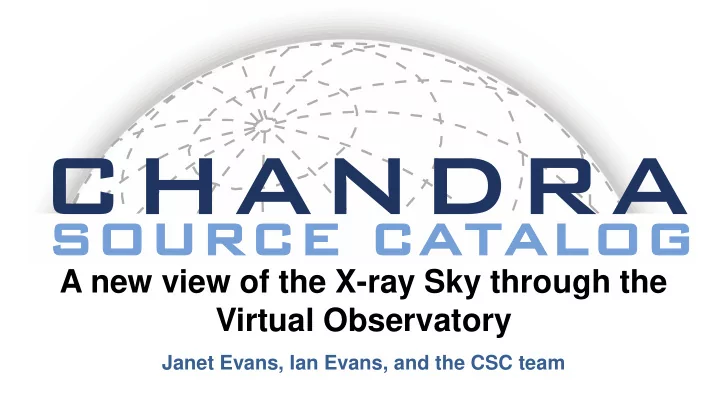

A new view of the X-ray Sky through the Virtual Observatory Janet Evans, Ian Evans, and the CSC team
Chandra X-ray Observatory July 23, 1999
Chandra Source Catalog Release 2 Mining the high-resolution X-ray sky Source positions, calibrated photons, multi- band X-ray photometry, images, spectra, and light-curves 10,382 observations (data sets) 374,349 X-ray detections 315,875 unique X-ray sources on the sky 245.8 Ms total exposure 5.8 Ms longest stacked exposure
Ultrasoft 0.04 Marginalized Probability Soft Density P(S) dS 0.03 Medium 0.02 Hard 0.01 0 0.0000 0.0001 0.0002 0.0003 - 2 s - 1 ) Source Flux S (photons cm Source position with error ellipses computed Multi-band X-ray aperture photometry with Source extent and local PSF models for from MCMC analysis Bayesian probability density functions every source and energy band Source properties — all have associated upper and lower confidence bounds Several source temporal variability measures within a single Observation of a source and Cross-band spectral Hardness ratios Spectral model fits and fluxes determined between multiple observations that include for all detected sources using multiple models the same source
Orion Trapezium cluster 1’
Orion Trapezium cluster Source detections 1’
1’
Orion Trapezium cluster Source detections 1’
Release 2 of the catalog includes extended X-ray emission in addition to point and compact sources Left: Tycho’s supernova remnant (888 ks; 58 million X-ray photons!) Below: Supernova remnant DEM L71 Large extended sources are identified by enclosing them in a convex hull polygon (cyan below). Position is the flux weighted centroid of the polygon.
Chandra Deep Field South Single observation
Chandra Deep Field South Growing the observation stack
Chandra Deep Field South Final stacked image 81 Observation stack; 5.8 Megaseconds
Chandra Deep Field South Source detections 81 Observation stack; 5.8 Megaseconds; ~1000 sources
VO Interfaces … Cone Search – position, radius SIA – Simple Image data Access TAP service – Table Access Protocol SAMP – Simple Application Messaging Protocol ~~~~~~~~~~~~~~~~~~~~~~~~~~~~~~~~~~~~~~ HiPs – Hierarchical Progressive Survey MOC – Multi-order Coverage Maps
Citizen Science… • The Chandra data is in the catalog • Applications that incorporate VO standards interoperate • Public use and education of X-ray and Multi-wavelength data thru the VO is a next step in education and use by the public at large
Center of the Milky Way Galaxy 71 Obsid stack; 2.2 Megaseconds; field is ~ 18’ across
Center of the Milky Way Galaxy Source detections
More info … Production of release 2 of the Chandra Source Catalog is in the last phase of processing. The complete catalog will be released in ~Feb 2018 For more details see the catalog website: http://cxc.cfa.harvard.edu/csc/ It is our hope & expectation that the CSC will be a rich virtual facility for X-ray astronomy and a long lasting legacy of the Chandra program
Recommend
More recommend